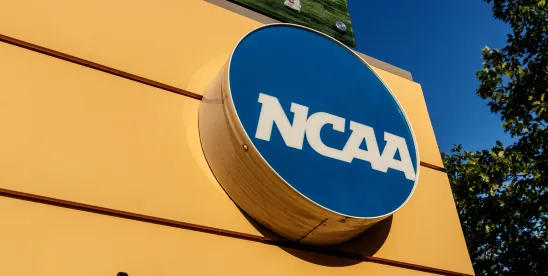In the latest development from the antitrust class-action lawsuit filed against the NCAA regarding potential compensation allegedly denied to student-athletes, Judge Claudia Wilken of the U.S. District Court for the Northern District of California granted preliminary approval to the parties’ settlement. If finalized, the settlement would grant $2.78 billion to thousands of college athletes over the next decade, and schools would have the discretion to share approximately 22% of revenue with student-athletes.
Background
As covered in our previous alert, House v. NCAA consolidated two cases filed by Division I college athletes (at Arizona State University, the University of Oregon, and the University of Illinois, respectively), alleging that the current NCAA rules are anti-competitive and violate antitrust laws. Specifically, the plaintiffs allege that the NCAA and its Power Five conferences conspired to exploit student-athlete behavior and that the NCAA’s restrictions on name, image, and likeness (NIL) payments and control of TV markets prevent student-athletes from realizing their true market value.
In addition to injunctive relief, the plaintiffs sought backpay to compensate them for these alleged lost NIL revenues. The potential losses included lost broadcast revenue, lost video game revenue, and third-party NIL deals that have occurred since 2016. On September 5, 2024, Judge Wilken initially rejected the preliminary approval of the proposed settlement citing concerns over the settlement’s proposed restrictions third-party NIL agreements and the definitions of “booster” and “pay for play.” The parties submitted a revised settlement on September 26, 2024, and Judge Wilken granted preliminary approval of the revised settlement on October 7, 2024.
The Settlement Agreement
Under the preliminarily approved settlement agreement, which would also resolve the Hubbard v. NCAA and Carter v. NCAA cases, the NCAA and the Power Five conference schools will pay $2.78 billion in damages to multiple categories of student-athletes as “back pay” as a result of the NCAA depriving these athletes of NIL opportunities and revenue sharing. The largest class in the settlement consists of Division I athletes who played sports from June 15, 2016, (due to the statute of limitations) through the present. However, the $2.78 billion will not be equally distributed. Approximately 75% is expected to go to football players, with 20% going to men’s and women’s basketball players and 5% for other athletes. The expected average damages award for a Power Five football or men’s basketball player is approximately $135,000 in payments over 10 years. Although the 27 non-Power Five conferences and their member schools were not defendants in the House lawsuit, these conferences and their schools are expected to bear about $990 million in costs. Power Five schools, by contrast, are expected to pay approximately $664 million, with the remainder paid by the NCAA.
Additionally, the preliminarily approved settlement establishes a 10-year revenue-sharing plan, allowing NCAA conferences and their member schools to share 22% of annual revenue with student-athletes. This revenue-sharing plan is permissive, not required. Most importantly, schools can also opt into an athlete pay model of sports revenue, which is capped at $22 million annually for each school (for all athletes in a given school’s athletic program, at the school’s discretion). This salary cap is the next step in moving college sports closer and closer to “pro-style” sports, with schools under this model now having to choose where and how to distribute that $22 million figure. The revenue-sharing figure is expected to grow up to $32.9 million by the end of the 10-year revenue-sharing agreement.
Under the preliminarily approved settlement, enforcement authority over third-party NIL deals will no longer extend to all third parties, including broadly defined boosters. Instead, restrictions will focus only on groups "of entities and individuals closely affiliated with the schools," such as collectives. Any NIL deals involving these "associated entities or individuals" must be approved through a third-party clearinghouse. The NCAA will not be responsible for reviewing these agreements; instead, they will be subject to neutral arbitration. An arbitrator will determine whether the NIL deals serve a "valid business purpose" or are merely pay-for-play schemes disguised as NIL agreements.
Other key pieces of the settlement agreement include required reporting of all third-party NIL deals valued at $600 or more, a removal of scholarship limits (although scholarships will still count towards the $22 million “salary cap” figure, up to $2.5 million), and provisions for NCAA regulatory oversight.
Next Steps and Takeaways
Now that Judge Wilken has granted preliminary approval, a notice campaign and claims period will begin on October 18, at which point current and former athletes will receive the settlement terms as well as claims procedures. The first payment for back damages is currently scheduled for May 15, 2025, or within 45 days of the settlement agreement’s finalization. The deadline for objections and claims will close on January 31, 2025, with a final approval hearing scheduled for April 7, 2025. Under the current schedule, implementation of the settlement terms will likely arrive in time for the 2025-2026 academic year.
The House v. NCAA settlement represents one of the most significant and dramatic shifts toward a more professional model for college sports. The settlement not only provides more revenue-sharing opportunities for student-athletes, but the introduction of a salary cap could fundamentally reshape the landscape of college sports. However, it does not address all the labor and employment issues in the field, as college athletes remain non-employees without the right to join labor unions. Moreover, the settlement agreement only resolves the three consolidated cases, it does not bar future potential antitrust claims from current and future college athletes, including plaintiffs in the Fontenot v. NCAA and Cornelio v. NCAA cases. Critics of the settlement argue that the revenue-sharing model could further widen the gap between the wealthy Power Five schools and their non-Power Five counterparts. Additionally, House v. NCAA may lay the foundation for the creation of a super conference or super league composed of high-revenue football and basketball programs in the future. For now, the settlement aims to level the playing field for all student-athletes, regardless of conference, while broadening NIL opportunities by allowing athletes to more closely link their financial success to that of their schools.
The settlement’s new revenue-sharing model will require schools to implement stricter controls over the distribution of NIL payments to ensure compliance with legal and regulatory frameworks. Schools will need to be prepared to take on greater responsibility in managing and overseeing NIL payments to ensure compliance with evolving regulations and rules. Questions remain about how to ensure Title IX compliance, as schools must balance the distribution of resources across men's and women's sports. Additionally, looming labor issues, including the potential classification of athletes as employees, may further complicate schools' responsibilities. Schools will need to be proactive in maintaining transparency, fairness, and legal adherence as the NIL landscape continues to evolve.




 />i
/>i

